|
This Month at Mass Hort
| Hors D'Oeuvres Party at Whole Foods
Wednesday, November 6
6:00 PM - 7:00 PM
Small plates, tapas, piattino - whatever your pleasure, let's take a new look at the old seen. Small plates restaurants are all the rave, but they are also the beginning of many events, maybe your upcoming holiday party? Why can't yours be the talk of the town.
Sign up here
Location: Whole Foods Market, 340 River Street Cambridge, MA 02139
Contact: Lisa Kamer - Massachusetts Horticultural Society - 617-933-4943 - lkamer@masshort.org
Mass Hort members - $15.00 Non-Mass Hort members - $20.00
| The Hidden Forest |
|
| Thursday, November 7 7:00pm - 8:30pm |
|
|
| |
We all know what the forest looks like. What very few of us know are the hidden organisms that nourish, protect, infect and destroy the visible portions of our ecosystems. More than 90% of the world's plants have fungal partners, without which the world would be a vastly different place. Fungi form an entire kingdom, more closely related to animals than to plants. Like us, they depend on plants for oxygen and carbohydrates. And, like us, they have a complicated relationship with the plant kingdom, acting sometimes as good gardeners and sometimes as destroyers. One lecture is not enough to tell you everything about this relationship but we promise that you'll never see the forest in quite  the same way again. the same way again.
Susan Goldhor is a biologist who is the President of the Boston Mycological Club, the oldest such club in the nation. Her essays about fungi, which have focused on their roles in ecoystems, have been widely praised for their clarity and style, as well as for popularizing aspects of fungi that have generally been the province of specialists.
|
Reserve your space here
 Festival of Trees
Massachusetts Horticultural Society invites you and your family and friends to our Festival of Trees display of beautifully decorated trees. Festival Dates
November 29 through December 15
Friday November 29th - Celebratory Opening Hours Weekends : 10 a.m. - 8 p.m. Weekdays: 4 p.m. - 8 p.m. Special Note On Sunday, December 15, the Festival will close at 6 p.m. in order to notify the tree winners. General Admission
$8 for Adults, Children under 12 FREE!
Children ages 14 or younger must be accompanied by an adult.
Location
The Gardens at Elm Bank Hunnewell Building 900 Washington Street Wellesley, MA 02482 Click here to learn more |
| Volunteers | |
Volunteer for the Festival of Trees and to help decorate the gardens!
Volunteer today! Mass Hort is looking for volunteers to help run programs, events, and join committees. Use your management, marketing, and people skills to help Mass Hort deliver its mission.
Learn more about volunteering at Mass Hort
Sign up today to volunteer! |
| Join Mass Hort |  For exceptional benefits to help you in the garden- Join Today! If you are a Mass Hort member- please recommend membership to a friend! Forward this newsletter. CLICK HERE TO JOIN |
Book Review
|
 The Year-Round Vegetable Gardener: How to grow your own food 365 days a year, no matter where you live Jabbour, Niki. (Storey Publishing, 2011) If you're the kind of person who looks out on a monochrome patch of land in November and mourns the end of the gardening season, this is the book for you. Niki Jabbour never has to pack up her gardening tools because she discovered that vegetables can be harvested in the dead of winter and has created devices that help them grow. She plants old favorite varieties and new ones, too, all on the edge of the Atlantic in cool, sometimes white, Nova Scotia. She encourages us all to try her kind of gardening, so we can enjoy fresh winter salads from our own back yards. She reminds us that one reason we should not be put off by cold is that cold doesn't matter as much as of hours of sunlight. We may still wonder why Ms. Jabbour is so successful when we examine the Hours of Daylight scale, which shows that Nova Scotia comes down only about a third of the way on a scale of increasing daylight lengths. Then, we remember that day length depends on latitude, and Halifax, Nova Scotia is at 44 degreesN latitude, the same as Bourdeaux, France, a renowned agricultural location. The scale starts with Prudhoe Bay, Alaska, where there are 0 hours of daylight on December 21 and goes all the way down to Miami, where there are 10 hours & 32 minutes. Boston, one presumes, would appear about halfway down the scale between Portland, Maine (8 hours, 56 minutes) and New York City (8 hours, 15 minutes). Much of the author's success is accomplished through unrelenting attention to the proper time for planting during one of the three growing seasons - cool, warm and cold - and by knowing the approximate date for the last spring frost and the first fall frost. The author delights the reader by introducing novelty vegetables and with a section on her favorite herbs. Her garden layouts are artistic, and she knows how to inspire by describing the flavors she enjoys during the extended growing season. Her advice that gardeners should produce only what they love to eat should be heeded by all. Practical advice permeates the whole book, as she tells us how to select a site, build a cold frame, and improve the soil. The photographs are detailed and colorful enough to whet every appetite. As an additional spur to anticipating each month, one could invest in a pictorial calendar showing the fruits and vegetables that thrive and are consumed across the year. Such a treasure is "Farmer's market: Four seasons of fruits and vegetables, 2014". Pears, which are popular in November, are shown on the month's page with several Bartletts, which were introduced by the Massachusetts Horticultural Society 180 years ago. The calendar, with its painterly illustrations, is published by Universal Publishing and is available at the Wellesley Book Store.
|
|
|
|
|
Letter from the President
Dear Friends,
 | |
Kathy Macdonald, President of the Massachusetts Horticultural Society
Photo by Andy Caulfield
|
I hope you are enjoying this beautiful fall. Last weekend I traveled west to Northampton to attend the Chrysanthemum Show at the Botanic Garden at Smith College (November 2-17) with my family. The colors and varieties of Chrysanthemums were beautiful! The following day, we hiked Mt. Tom to Goat's Peak and enjoyed the fabulous view of the Pioneer Valley and the Connecticut River. At Mass Hort we are working on developing programs and ideas for next year. I would love to hear from members about your suggestions for programs and activities, or if you would like to serve on a committee. Click on SUGGESTION BOX or give me a call at 617-933-4955. Enjoy the fall. I hope to see you at the Festival of Trees, beginning November 29th! Warm regards, Kathy |
 Festival of Trees 2013 Festival of Trees 2013
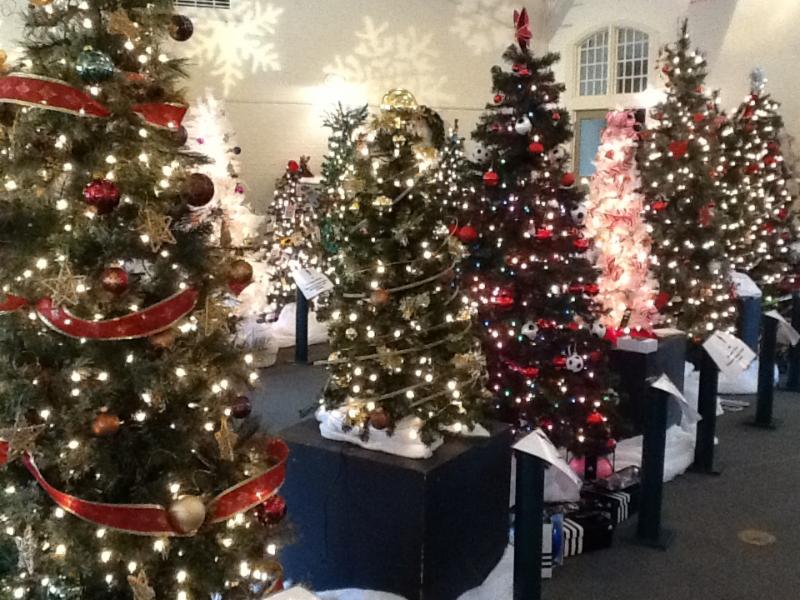 A glow from many lights will pierce the darkness this holiday season when the Festival of Trees takes over Elm Bank from Friday, November 29 through Sunday, December 15. Mass Hort's 5th annual gala will continue the tradition of entertaining celebrants of all ages. The two week long event will open on the day after Thanksgiving with a festive celebration including horse-drawn hay rides, balloons, a visit from Santa, and of course a decorative carriage house filled with more than sixty trees to be raffled off. This year Mass Hort's elves have been working hard to garner trees and activities to fill the two week celebration with something for everyone. A variety of hands-on workshops for adults and children, music, candy canes, horses, Santa, and shopping all done with the backdrop of beautifully decorated trees and holiday excitement are sure to produce joy and good cheer. A new tradition, the popular Gardeners' Gift Boutique, which started last year, will return on Thursday, December 5, from 4:00 p.m. to 8:00 p.m. This sale of beautifully crafted local products is back and has been expanded to include more vendors. Enjoy holiday shopping in an intimate atmosphere while supporting local vendors and craftsmen. The decorated trees are all donated by individuals, organizations, businesses, and design studios who choose a theme and then decorate to please visitors. Tree themes range from sports teams, childrens' delight, traditional and Victorian Christmas, and Hanukkah, to a tree sculpted from branches, nature, food and drink, and of course, honoring gardens and gardeners. For some, the most attractive tree will be the Giving Tree, laden with gift certificates reaching a total value of more than $1,500 from local businesses. Hands large and small carry raffle tickets from tree to tree hoping to win the Princess tree, the Engineer tree, the Craft beer tree, the Red Sox tree and so many more. The display will delight thousands of visitors during the two week run of the event. Be sure not to miss this brief but delightful holiday adventure. Festival Hours: The hall of lighted trees in the Hunnewell Carriage House will be open: November 29th - Opening Day - 10:00 to 8:00 Weekdays - 4:00 to 8:00 Weekends - 10:00 to 8:00. Please note that pre-registration will be required for all workshops. Private group tours will be conducted by appointment Monday through Friday during the run of the show. Tours have been offered to Councils on Aging in various towns and to senior residential facilities. There is a discounted admission rate for the group tours, and although response has been enthusiastic, there are still some openings. To inquire about tours, call 617-933-4934 or email Festivaloftrees@Masshort.org. To find specific dates and descriptions of all the events, and to register for workshops, please visit www.Masshort.org/Festival-of-Trees. See the Festival of Trees flyer |
Planting Daffodils: A Good Idea with Perfect Timing
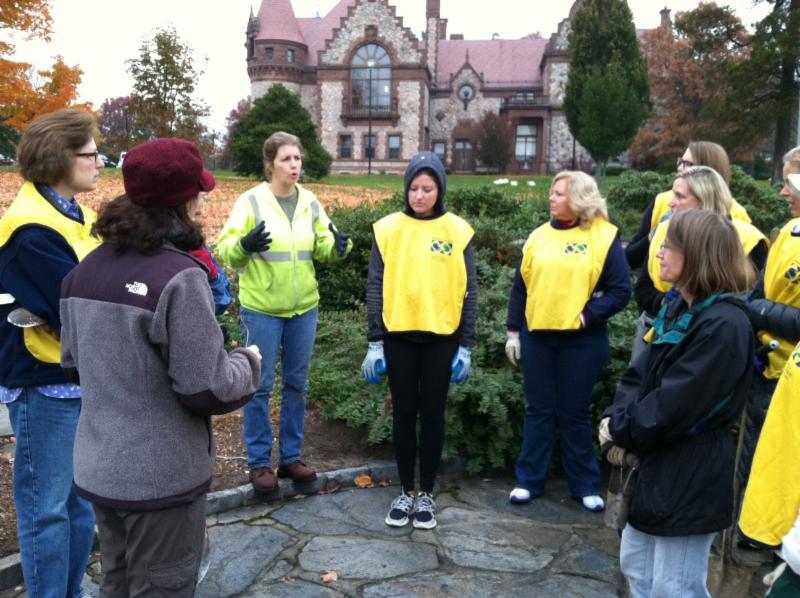 | Volunteers by the Wellesley Town Hall
with Wellesley horticulturalist Suzie. |
Next spring, just in time to remember the tragic happenings at the Boston Marathon, Natick and Wellesley, and the other towns along the route to the finish line, will be awash in daffodils. A river of yellow, nature's most cheerful color! Thanks to thousands of volunteer bulb planters, organized under the banner of "Marathon Daffodils", 100,000 blossoms will burst out from Hopkinton to Boston, signaling a rebirth of community connection. 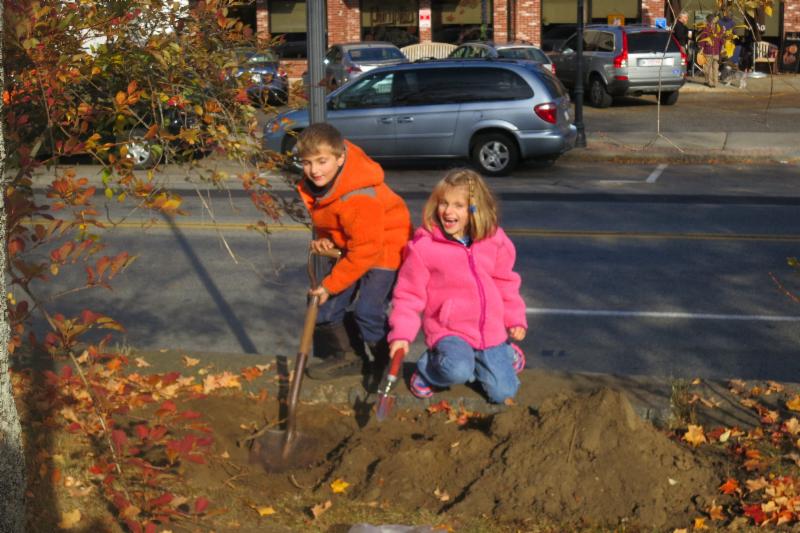 Mass Hort's President, Katherine Macdonald, commented: "Marathon Daffodils has provided an opportunity for volunteers from across the state to come together in the spirit of civic pride and make a positive statement of beauty and celebration for the Boston Marathon runners and fans next April." Mass Hort's Marathon Daffodil responsiblity includes plantings in the towns of Wellesley and/or Natick. To volunteer: Wellesley: contact Deborah Brown at deborah100@gmail.com Natick: contact Art Goodhind at agoodhind@natickma.or. To volunteer in other towns, please contact Marathon Daffodil organizers at :marathondaffodils@gmail.com For information on planting techniques and places to buy bulbs for homeowners along the route, connect to the Mass Hort website, www.Masshort.org, under Programs & Education or click here: Marathon Daffodils. |
Horticultural Luminaries Recognized
By Hilda M. Morill
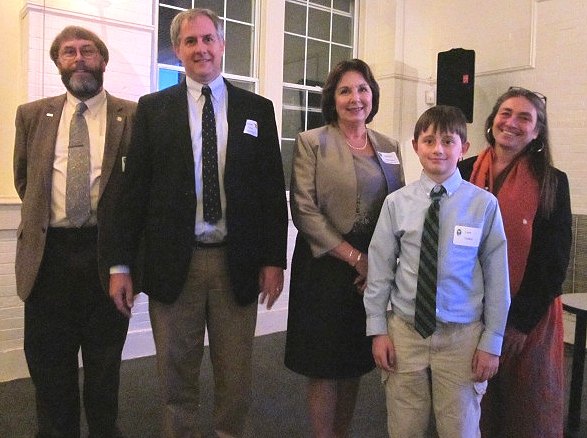 | |
From left to right, Wesley Autio, Director, Stockbridge School, Bill Cullina, Executive Director of Coastal Maine Botanic Garden, Kathy Macdonald, President, Mass Hort, Liam Cullina, and Katherine Tracey of Avante Gardens. Photo by Hilda M. Morill |
For more than a century, the Massachusetts Horticultural Society has recognized individuals of great merit in the world of horticulture by awarding coveted medals in honor of their service, accomplishments, and record of achievements. Considered among the most prestigious horticultural awards in America, the medals are given once a year to those whose nominations are submitted to the Honorary Medals Committee and approved by the Board of Trustees. Through the years we have been honored to attend and report on the gala event. Awardees have visited the Greater Boston area from far and wide, bringing to mind the late Rosemary Verey, the internationally renowned plantswoman, garden designer and writer, who in 1998 traveled all the way from Barnsley House in Gloucestershire, England, to the festivities held that year at the Boston Harbor Hotel. This year's awards were held on October 17 in the Hunnewell Carriage House at Mass Hort's home, the beautiful Elm Bank Reservation in Wellesley. Guests enjoyed a cocktail reception followed by a delicious dinner from Pepper's Fine Catering's "Farm to Table" menu. Jeanne Leszczynski, Chair of the Board of Trustees and Katherine Macdonald, Mass Hort's President and Executive Director, graciously welcomed everyone to the 114th Honorary Medals presentations. The keynote speaker, and recipient of the George Robert White Medal of Honor, was William Cullina, Executive Director, Coastal Botanic Garden in Boothbay, ME. Mary Ann Streeter of Wenham, MA, a distinguished horticulturist and longtime volunteer, received The Thomas Roland Medal. Gold Medals were presented to: Brookline's Allandale Farm for promoting urban farming and community involvement, including: John Lee, General Manager, and owners Edward Lawrence, M. Lee Lawrence Albright, Robert Lawrence and James Lawrence; Arthur Scarpa, of Reading, MA, longtime Mass Hort volunteer, for excellence in growing cacti and succulents; Garden Club of America, celebrating its 100th anniversary this year, for working to promote a greater understanding of the importance of horticulture, environmental protection, and community improvement across the U.S.; and the Stockbridge School of Agriculture, University of Massachusetts, celebrating its 150th anniversary, for leadership in agricultural education. Receiving Silver Medals were: Katherine Tracey, of North Dartmouth, MA, for horticultural excellence and unique plant offerings at Avant Gardens; and David Epstein, the noted meteorologist, writer, and gardener. The 2013 Honorary Medals committee members included Scott Birney, Diane Cullen, Betty Ferris, Paul Rogers and Carrie Waterman. In his delightful keynote presentation, "Gardening On the Edge of the Continent," Mr. Cullina shared that he propagated his first plant (a Christmas Cactus) when he was 8-years-old and how he still delights in "growing" friendships. Seeing the wonderful photos of the development of the ocean-front property that is now the famous Coastal Maine Botanic Garden, it was hard to imagine that in 1995 the property was scheduled to be developed for housing. Through the devotion and efforts of volunteers, the original gardens featured wildflowers only before the hiring of a landscape gardener in 2004. A visitor center was built in 2006, a children's garden in 2010 and an education center in 2011. This year alone, 120 programs were sponsored. Trip Advisor recently named them as the #1 Botanical Garden in the country. Cullina's goal for 2014 is to provide access to the waterfront and "take advantage of the Atlantic," as he said, for the expected 98,000 visitors. Incidentally, he noted that the gardens are open in winter when there is no charge for admission. Congratulations and Best Wishes to all. We are already looking forward to next year's awards and look forward to seeing you there. (Hilda M. Morrill is the publisher/editor of www.BostonGardens.com, a gardening website which focuses on the Greater Boston Area and Massachusetts in general. A longtime member of Mass Hort and the Garden Club Federation of Mass, she has been writing and lecturing about gardens and gardening for more than 45 years.) |
Notes from the Vegetable Garden
Susan Hammond
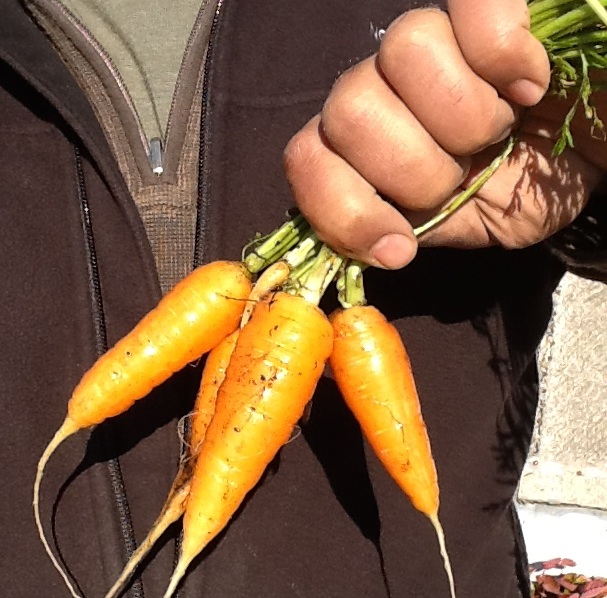 | Fresh baby carrots on October 28th
|
Over 4000 pounds! That's what we produced this year in the Garden to Table Garden.
In October we see a real transition in this garden; the only thing planted is cover crops, and harvest shifts from the warm weather beauties like tomatoes to the fall crops like parsnips and horseradish - or real baby carrots.
This garden is a team effort, from planting in the spring to the very last harvests in the fall. Volunteers make it all happen!  | | Shelling dried beans in the October sun |
We wrapped up our harvesting season on October 28th, with a final shipment of over 150 pounds to the Wellesley food pantry. Now we shift our focus to putting the garden to bed for the winter and planning what we will grow next spring.  | | Volunteers loading up the late harvest |
The Garden to Table program is active all year long, and we are looking forward to working on the indoor vegetable garden at Tufts during the winter. To keep up with what's going on, please visit us on the web at: http://www.masshort.org/Garden-to-Table-Program .
|
A Gardener's Work is Never Done
By Neil Sanders
Leaflet Contributor

A few mornings ago, I was awakened at 5:35 a.m. when our cat walked into our bedroom and let out a single, very loud 'meow'. The cat then went downstairs where it emitted multiple noises that sounded for all the world like a cement mixer missing one or more ball bearings. Our cat is not normally so talkative, so we put on our robes and went downstairs to see what had upset our normally (except at mealtime) placid pet. The answer was immediately obvious: outside our front door, two deer were sizing up our holly bushes as a breakfast entrée. Welcome to the gardener's world, where the end of summer and the growing season are just pencil marks on a continuum of chores that span the year. I categorize those chore into four baskets: things we don't know we have to do until reality tells us we better do them 'now'; things we put off doing during the summer because it was too darned hot; things that you can't hurry; and things that need to get done, and autumn seems like the right time of year to do them. For example, the morning of the meowing cat begat an hour of spraying every evergreen in our garden with a nasty commercial concoction of putrefied eggs and garlic and a reminder on our calendar to repeat the process in six weeks. That's a prime example of a chore that comes up and smacks you on the back of your head. Spraying is second nature while the garden is in its full flower. It takes a couple of deer on your doorstep to drive home the reminder than deer repellent needs to be applied even after the tastiest morsels are history. 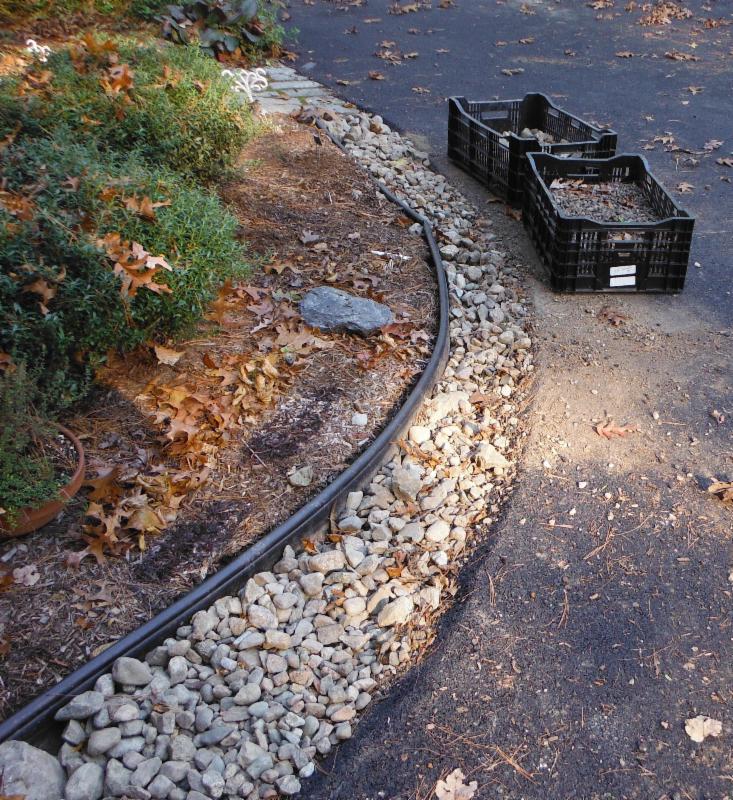 | | Rock border |
The late autumn is also when projects that were put in abeyance because of the summer's heat come home to roost. We had a portion of our driveway repaved in July. Now that the weather is cooler, we are re-installing a rock drainage border around the driveway. It sounds like a simple task until you consider that the contractor performing the repaving work made no effort to preserve our earlier border. As a result, new drainage channels must be created, shaped and filled with rocks that have sat in crates for several months. Is it a gardening project? Absolutely. The drainage borders protect the gardens that surround the driveway from rainwater that would otherwise wash those gardens away. Taking down the gardens in the autumn is a gradual process that requires respect of both nature and reality, and so stretches well beyond the end of Daylight Savings Time. A large bed of daylilies was cut down in late September when the foliage yellowed. Honeybees, however, still feasted on the asters that were interspersed among the daylilies. And so that part of the cleanup was put off. Now that the asters have passed, I am going around dutifully completing that part of the project. 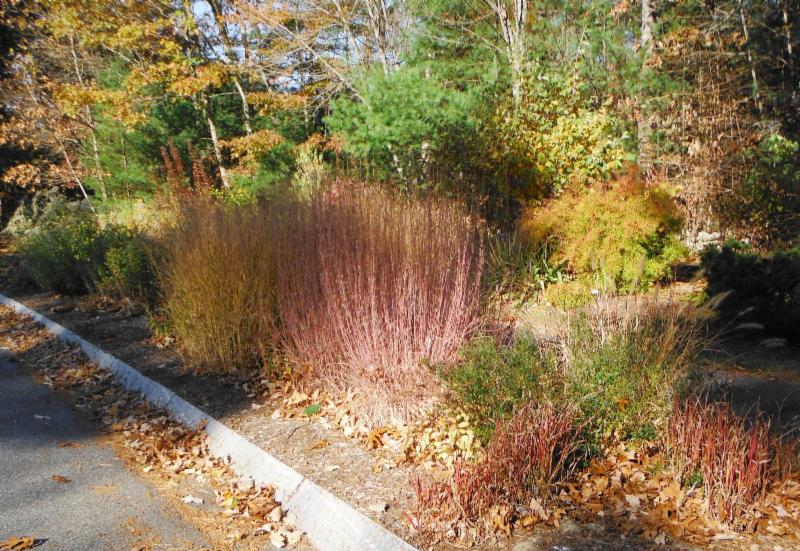 | | Colorful grasses |
We also have tall grasses that come into their glory in October and November. They wave in the breeze at the front of our property and are impervious to frost. Cutting them down early would be senseless. But the first snow of the season will leave them looking disheveled and forlorn. As soon as that first snow of the season has fallen and melted, those grasses will need to come down. Finally, late autumn is also the time for those projects on the 'long term' list. Several years ago, I insisted that a part of the back of our property be cultivated as 'seedeaters' heaven', a stand of tall rudbeckia, hellenium and other plants that would provide a wealth of seeds for the avians that keep down the insect population of our garden. It was a great and noble idea in theory. In practice, it never looked good and quickly became an overgrown mess filled with weeds and unwanted interlopers. Now that the days are cool, my responsibility is to grub out the area so that it can be replanted more sensibly. In undertaking these projects, we race against the calendar. Sometime in November or December, it will be too cold to work outside and the days will be too short to get work done. When that happens, we throw in the towel and retreat indoors to contemplate seed catalogs for the 2014 season.
But not, of course, until I've split enough wood to get through the New Year.
Neal's newest mystery, which continues the saga of The Garden Club Gang, will be published this month. Look for it on Amazon.com and at bookstores.
|
|
November Horticultural Hints
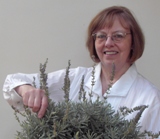
by Betty Sanders
BettyOnGardening.com
Clean Up Continues: Our frost-free days ended abruptly in late October so now there is no longer any excuse to delay cutting down your spent annuals and perennials. Compost healthy foliage, send those that suffered from disease to the dump.
Water! Water! Please. At the end of October we were more than three and one-half inches below normal for rainfall. Trees and shrubs need autumn rains to prepare for the long dry winter ahead. Keep the hoses out and give your woody plants weekly waterings until the ground freezes. 
If you wrap your needled evergreens for winter, skip the burlap and use bird netting. The object is not to protect the plants from the cold, but to protect the branches from being splayed or broken by heavy snows. The netting will do that while allowing you to enjoy the beauty of the evergreens.
Still Mowing. Keep mowing the lawn both to chop up leaves and to keep the grass in line. As the days get colder, drop the mower height to two inches so the grass is less likely to suffer snow mold over the course of the winter.
You can get two chores done at once by adding a grass catcher as you mow an un-raked lawn. Mowers do a great job of chopping up leaves, which can then be spread into flower beds or under shrubs and trees. Chopped leaves won't blow over the course of the winter. By spring, they will have broken down, enriching the soil and feeding your plants.
Not All Garden Crops Die with the First Frost. The vegetable garden may still have lettuce, spinach, leeks, Swiss chard, turnips, carrots or Brussels sprouts growing. Enjoy the fresh produce into the winter by keeping a cold frame going. Once you have put the cover over it, you will need to water the vegetables inside for them to continue growing.
Put a mulch of straw over the strawberry beds to protect them throughout the winter.
Clean-up and bury or compost all dropped apples and other fruits to limit the spread of disease. Wrap fruit tree trunks with plastic tree guards to protect against damage by rabbits, rodents and others who would damage the trees' bark.
The Not-So-Sweet Vine. The cold weather means you can enjoy a walk in
 | | Bittersweet |
the woods and fields. If you come across bittersweet, look at it carefully. The oriental bittersweet (which is what we usually see) is a highly invasive intruder and should be cut down, bagged and sent to the incinerator. It covers and kills trees in the forest and around the edges of fields. It is illegal to sell items made of oriental bittersweet. The decorative wreath on your front door will be eaten by birds and then many bittersweet plants will bedevil your garden and your neighborhood for years to come. You can tell the difference between the nasty oriental and the friendly native bittersweet by remembering that, on the native plant, the red berries hang in clumps while they are spaced along the vine on the oriental species.
Indoor Gardening. Your indoor plants should have somewhat adapted to the loss of light and the dryer air they encountered after being moved in for the winter back in September. The rule now is to use less water and no fertilizer until early February. Houseplants will not begin growing again until they get more light. Keep humidity up by clustering plants and placing them on trays of pebbles to which you regularly add water to just below the bottom of the pots. If you grow cactus, stop all water during through this period because they plants are naturally adapted to a winter drought.
_____________________________________________________________
Look for more gardening tips at BettyOnGardening.com.
|
Volunteer Spotlight: Jeff Rosen
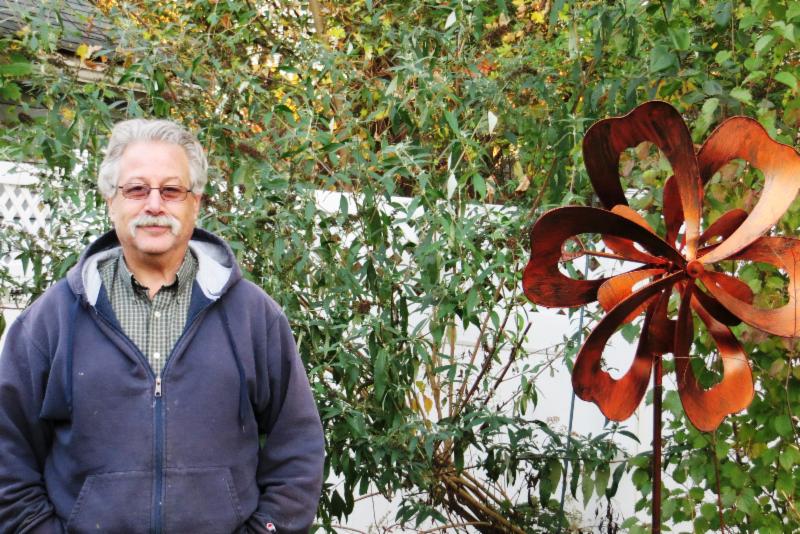
Jeff Rosen is a gardening volunteer who likes to see change and improvement. He comes to that wish naturally because, as a near neighbor, he has been walking Elm Bank's paths since 1986, back in the era before Mass Hort's arrival, and it's our long-time neighbors who best appreciate the benefits of the Society's hard work.
Jeff first pitched in with the work three years ago because volunteering was a requirement for his Master Gardner certification, but he showed so much dedication that he was asked to be the Crockett Garden Keeper. His favorite part of the job is observing the changes in his plants from early spring to fall.
He tried gardening at his own home for many years, making lots of mistakes, but always reading to improve and to adapt gardening rules to his property. Adaptation is still his goal, as he seeks to choose plants for the Crockett Garden, while being alert to the possibility of moving them if they don't thrive. Visitors should take the time to notice the improvements Jeff has made, for example, the pot sculptures at the entrance to the garden and the cobblestone border around the perimeter to define its entrance and exit. Ask him questions, if you like; he has information even on non-gardening subjects, such as eBay, on which he taught a class at the Natick Senior Center. At all times, be prepared to listen to his praise of Mass Hort.
|
|
Floral Design at Mass Hort
by April Daley
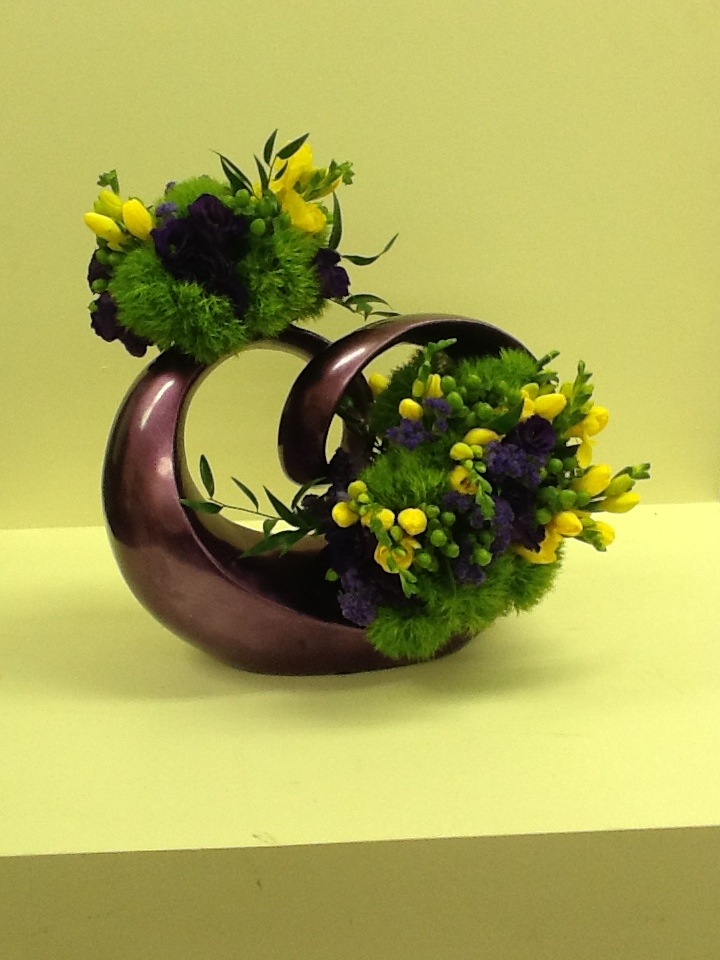
On Tuesday September 17 a group of floral designers gathered in the education building at Elm Bank for the first of six weeks of classes. This was the third time in two years Mass Hort offered this course in floral design for "beginners". The course offers instruction to people who have thought they might like to enter into a flower show but were hesitant to put the first toe into the waters.
Each week a different instructor guided attendees through the steps of creating a design for a flower show. From the concept to the paperwork to the finished product nothing was overlooked. Accomplished floral designers, most of whom are also certified flower show judges , the upper echelon of Garden Club hierarchy, and blue ribbon winners many times around offered their advice on the dos and don'ts of placing in a show.
Mass Hort offers this course with the goal of supporting the art of floral design, most often practiced by garden clubs, as well as to encourage participation in the Amateur Competitions of the Boston Flower and Garden Show, which takes place each March at the Seaport World Trade Center. On completion of the course designers are encouraged to enter into the upcoming Boston exhibition through Division II, open to all, or through Division I, which is open only to members of the National Garden Clubs.
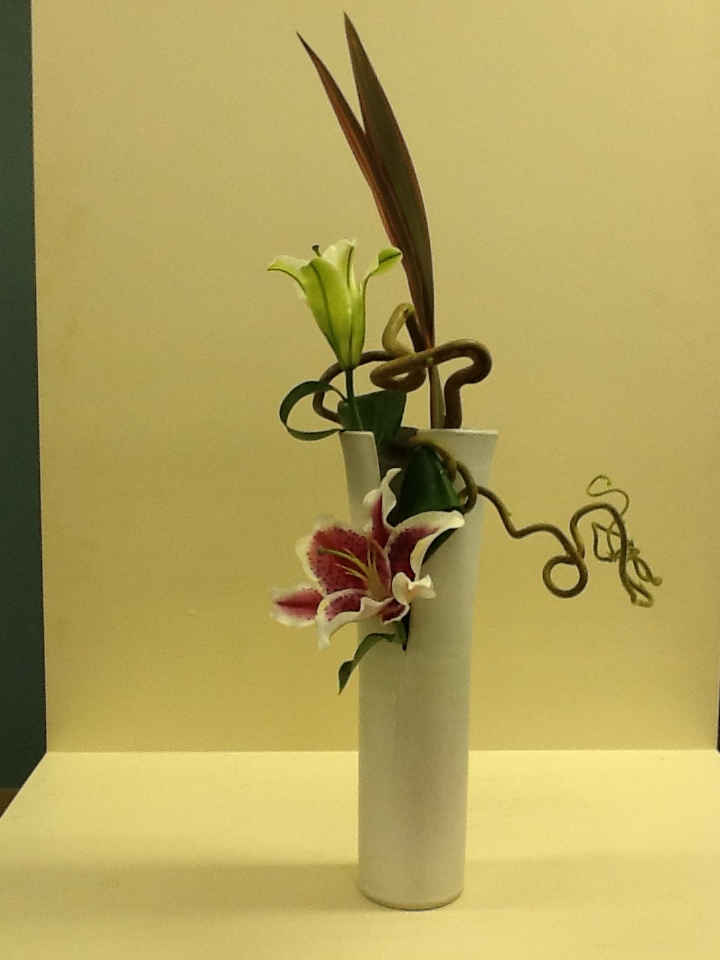 In the last class In the last class of this six week course the "newbies" were given the chance to create a design from several categories and to have that design judged by a panel of flower show judges. This particular exercise seems to incite a great deal of anxiety among the class participants. And at the same time, on the day of the "show" the room was filled with excitement and abuzz with admiration for the materials and the designs that started to emerge.
Interestingly enough, the show results supported the concept of the class. It was nearly impossible to evaluate the designs presented for judging as being those of so called beginners. Some designs left the judges searching for suggestions as the displays clearly represented the work of individuals who came to this with more
than a bit of knowledge about presentation, balance, and color. Or perhaps, the instructors are really just that good.
Judge for yourself. .
|
Limited Edition Guy Wolff Massachusetts Horticultural Society Pot and Amaryllis for the Holidays
This beautiful pot and amaryllis is offered only to Massachusetts Horticultural Society members. White Flower Farm, Guy Wolff, and Massachusetts Horticultural Society have teamed up to develop this unique gift. To order, please visit: http://www.whiteflowerfarm.com/86496-product.html |
|
|
|
|
|
|